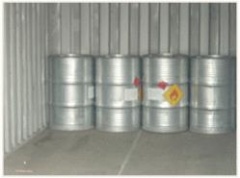Butanol
| Infobox on Butanol | |
|---|---|
| Example of Butanol |  |
| Facts | |
| Origin | - |
| Stowage factor (in m3/t) | - |
| Humidity / moisture | - |
| Ventilation | - |
| Risk factors | See text |
Butanol
Description / Application
Butanol (also butyl alcohol) refers to a four-carbon alcohol, with a formula of C4H9OH. There are four possible isomeric structures for butanol, from a straight-chain primary alcohol to a branched-chain tertiary alcohol. It is primarily used as a solvent, as an intermediate in chemical synthesis, and as a fuel. It is sometimes also called biobutanol when produced biologically.
Like many alcohols, butanol is considered toxic. It has shown low order of toxicity in single dose experiments to laboratory animals and is considered safe enough for use in cosmetics. Brief, repeated overexposure with the skin can result in depression of the central nervous system, as with other short-chain alcohols. Exposure may also cause severe eye irritation and moderate skin irritation. The main dangers are from prolonged exposure to fumes. In extreme cases this includes suppression of the central nervous system and even death. Under most circumstances, butanol is quickly metabolized to carbon dioxide. It has not been shown to damage DNA or cause cancer.
Butanol is considered as a potential biofuel (butanol fuel). Butanol at 85 percent strength can be used in cars designed for gasoline (petrol) without any change to the engine (unlike 85% ethanol), and it contains more energy for a given volume than ethanol and almost as much as gasoline, so a vehicle using butanol would return fuel consumption more comparable to gasoline than ethanol. Butanol can also be used as a blended additive to diesel fuel to reduce soot emissions.
Butanol is used as a solvent for a wide variety of chemical and textile processes, in organic synthesis and as a chemical intermediate. It is also used as a paint thinner and a solvent in other coating applications where it is used as a relatively slow evaporating latent solvent in lacquers and ambient-cured enamels. It finds other uses such as a component of hydraulic and brake fluids.
It is also used as a base for perfumes, but on its own has a highly alcoholic aroma.
Salts of butanol are chemical intermediates; for example, alkali metal salts of tert-butanol are tert-butoxides.
Shipment / Storage / Risk factors
Flammability of the Product : Flammable
Autoignition Temperature : 343°C
Flash Points : Closed cup: 28.9°C; Open cup: 36.1°C (97°F)
Flammable Limits : Lower: 1.4%;Upper: 11.2%
Products of Combustion : These products are carbon oxides (CO, CO2).
Fire Hazards in presence of various substances: Highly flammable in presence of open flames and sparks. Flammable in presence of heat, of oxidizing materials, of reducing materials, of combustible materials.
Storage
Store in a segregated and approved area. Keep container in a cool, well-ventilated area. Keep container tightly closed and sealed until ready for use. Avoid all possible sources of ignition (spark or flame).
For overseas carriage aspects of Chemicals, the readers are recommended to acquire or have access to a good chemical dictionary, and a copy of the International Maritime Dangerous Goods (IMDG) Code, issued by the International Maritime Organisation. Also consult the applicable MSDS sheet.











